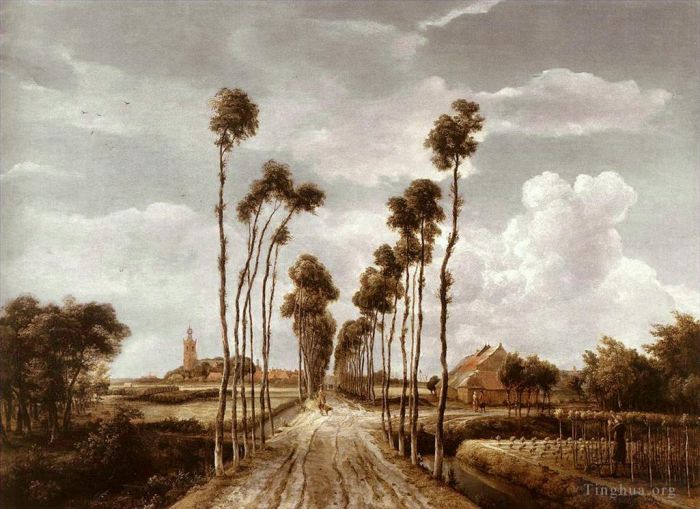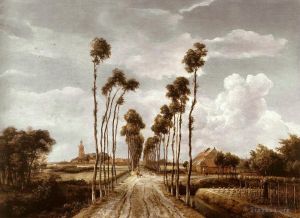The Alley at Middelharnis
Meindert Hobbema
- Price: Price on Request
- Art Type: Oil Painting
- Size:
- English Comments: 0
- International Comments: 0
- Creating Date:
- Introduction and Works of Meindert Hobbema >>
Keywords:
Alley, Middelharnis
Work Overview
- The Avenue at Middelharnis
Meindert Hobbema
1689
Oil on canvas
103.5 x 141 cm
The painting shows the village and church of Middelharnis in the province of South Holland. The view is remarkably accurate and has hardly changed since the 17th century. Hobbema's design with the avenue of trees receding towards the centre of the picture is simple yet at the same time majestic. The trees are employed to mark the quick recession from foreground to background while the expanse of sky is emphasised by the upward-pointing trees. Unfortunately the paint of the sky was damaged by cleaning some time in the 19th century; the billowing cloud to the right is the best preserved section.
Before 1660, Hobbema had been the pupil of Jacob van Ruisdael. However, by 1689 Hobbema was not painting for a living anymore. In 1668 he had obtained a well-paid job with the wine-importers' association of Amsterdam, and from then on seems to have painted only occasionally. The present painting is one of only a handful of pictures from this period.
The Avenue at Middelharnis is a Dutch Golden Age painting of 1689 by Meindert Hobbema, now in the National Gallery, London. It is in oil on canvas and measures 103.5 by 141 centimetres (40.7 in × 55.5 in). It shows a road leading to the village of Middelharnis on the island of Goeree-Overflakkee in the Maas delta in South Holland, the Netherlands.
The painting has long been one of the best-known Dutch landscape paintings,[1] and certainly Hobbema's best-known work,[2] at least in the English-speaking world: "it is as if the artist had produced only a single picture" according to Christopher Lloyd.[3] Cornelis Hofstede de Groot, the great specialist of a century ago, thought it "the finest picture, next to Rembrandt's Syndics, which has been painted in Holland".[4] According to Michael Levey, "it occupies a position in painting somewhat equivalent to that in poetry of Gray's Elegy,[5] and for Seymour Slive "it is the swan song of Holland's great period of landscape painting which fully deserves its high reputation."[6] For Gerald Reitlinger, it "soars above the other nine National Gallery Hobbemas".[7]
The untypically symmetrical and frontal composition of the painting appears to record very accurately the view Hobbema saw;[8] the alder trees along the road were planted in 1664.[9] It is signed and dated in the reflection on the ditch at right: "M:hobbema/f 1689", [10] over twenty years after Hobbema largely gave up painting,[11] and right at the end of the Dutch Golden Age landscape period.
The village is seen from the south-east. The road was called the Boomgaardweg, but is now the Steene Weg.[13] The top of the church tower has been rebuilt, and the spire was removed by the French in 1811 to make a semaphore station, connecting The Hague with Paris. The smaller tower to the right of the church, seen between the trees, is the town hall, built in 1639, and the barn to the right survived until the 1870s.[14]
The village lies on the edge of the island and was a fishing port; ships' masts and a beacon with a tripod support can be seen in the distance to the right of the avenue, on the beach facing the Haringvliet.[15] This was then a salt-water channel, but has been dammed and turned into a fresh-water lake in modern times. The island was detached from the mainland when the Haringvliet formed as a result of two major flooding events. The first was in 1216, which breached the dunes of Voorne and created a deep saltwater inlet. In the St. Elizabeth floods of 1421, this inlet connected to the Merwede and became an important estuary of the Rhine and Meuse rivers.
The unusually centralized composition carries the viewer's eye down the road, and the thin, very tall lopped trees unite the sky and the land. The head of the gentleman with his dog is at a level with the vanishing point of the perspective, and very close to it. He is a hunter, with a gun sloped over his shoulder, and a satchel for his game.[23] The "dark patches of ground and vegetation to the left and right of the road echo and reinforce the horizon line and counteract the inward pull of the perspective."[24]
In 1980 x-ray radiography revealed that Hobbema had originally placed another tree in the foreground on each side of the avenue, but then painted these over.[25] Erica Langmuir suggests that the two additional trees at the front were painted over because Hobbema decided that they would have "screened off the background from the foreground at the sides of the painting while exaggerating the 'rush' to the vanishing point in the centre." She suggests testing this by holding pencils over a reproduction.[26]
For Seymour Slive the painting has "the exalted spaciousness which often characterizes the Late Baroque, and also a kind of elegance in the elongated, slender trees that goes with the taste of this phase".[27]
Though unusual, there had been a few previous compositions with "a strongly foreshortened road lined with trees in a wide flat landscape". Aelbert Cuyp had painted The Avenue at Meerdervoort in 1650–1652 (now in the Wallace Collection).
It was perhaps because the two painted-over trees in the foreground had begun to show through that the sky was extensively repainted in the 19th century. This was realized in 1972 after analysis of the pigments used found synthetic ultramarine and chrome yellow in the sky, which had not yet been invented in the 1680s. A 19th-century restorer may have attempted to bring back the two trees, before thinking better of it, as Hobbema himself had done.[28]
The sky was largely repainted in 1951, much of which was removed in 1972, which "gave the painting an unsatisfactory appearance", so in 1980–81 all the 1951 repainting was removed and new retouches added. In contrast the landscape and trees are "very well preserved", although the colour balance of the greens has probably altered to give a "lighter and bluer shade of green than originally intended".
- Copyright Statement:
All the reproduction of any forms about this work unauthorized by Singing Palette including images, texts and so on will be deemed to be violating the Copyright Laws.
To cite this webpage, please link back here.
- >> English Comments
- >> Chinese Comments
- >> French Comments
- >> German Comments
- >>Report









 Singing Palette
Singing Palette